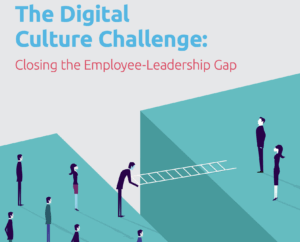by: Daniel Hebert at PostBeyond
Remember when the internet was called “the world wide web” or “cyberspace?” It seems like so long ago! So long ago, in fact, that we can laugh at those terms now. They’ve almost become misnomers at this point.
I’m now wondering whether we’ll be saying the same about “digital” in a year’s time. Some experts would argue that “digital” as a prefix already has reached redundancy. It’s no longer necessary to declare that you specialize in “digital marketing.” The assumption (if you work in marketing) is that you have an understanding of the digital landscape.
We’re seeing enterprise businesses embarking on a “digital transformation.” Definitions on what that entails can vary. Switching to cloud-based solutions, eliminating brick and mortar storefronts – the options are endless.
But we’ve been hearing from leading industry experts that becoming a digital organization isn’t really a fully-formed outcome. Digital is the catalyst for change, not the result of it. Or as one of our program managers, Mark Jordan of SickKids Foundation put it “digital is a vehicle, but not the vehicle.”
At PostBeyond, we challenge enterprises to adapt to the changing workplace. We encourage organizations to critically examine their communications processes and implement innovative new ideas. And we love being apart of the change with our customers.
This is exactly why we love Brian Solis’ latest framework for businesses undertaking a digital transformation. Rather than diving into a digital transformation, Brian suggests that enterprises takethe OPPOSITE approach.
Eight Success Factors of Digital Transformation
Don’t be fooled – “opposite” in this case doesn’t mean sitting around waiting for change to come your way. It means taking a deep and strategic approach to change at your enterprise.
- Orientation: Establish a new perspective to drive meaningful change.
- People: Understand customer values, expectations and behaviors.
- Processes: Assess operational infrastructure and update (or revamp) technologies, processes and policies to support change.
- Objectives: Define the purpose of digital transformation, aligning stakeholders (and shareholders) around the new vision and roadmap.
- Structure: Form a dedicated digital experience team with roles/responsibilities/objectives/accountability clearly defined.
- Insights & Intent: Gather data and apply insights toward strategy to guide digital evolution.
- Technology: Re-evaluate front and back-end systems for a seamless, integrated and native customer (and ultimately employee) experience.
- Execution: Implement, learn and adapt to steer ongoing digital transformation and customer experience work.
This framework encourages enterprises to approach “digital” in the right way. It isn’t as simple as snapping your fingers and pushing modernity on an outdated workforce. In fact, Brian warns that digital transformation is often a matter of politics. You’ll be fighting an uphill battle by asking leaders in your company to change their perception.
Yep, it’s a marathon, not a sprint.
And even further, it goes beyond technology. The OPPOSITE framework that Brian suggests is intended to move the focus away from technology or tools, and instead focusing on a more holistic change.
It’s my opinion that a digital transformation is more of a shift in perspective than it is of infrastructure. It’s a focus on communicating both internally and externally with people.
Digital Transformation and Employee Advocacy
Many of our program managers are the mobilizers of digital change at their enterprise. And we LOVE working with them! It’s awesome to see their excitement in bringing forth a fundamental change to their company.
That said, a tool or platform itself isn’t the entire solution. Our Customer Success team will tell you that executive buy-in (and leading by example) is paramount to implementing a company-wide change. Without executive buy-in, pieces of technology risk becoming “band-aid” solutions.
As an employee advocacy software, we run into some resistance here and there. Mostly from a place of concern, but sometimes from people or groups who have difficulty imagining a workplace where employees are actively involved in brand efforts. When the idea of “personal” and “professional” being completely separate identities is so deeply ingrained in some workplace cultures, asking employees to talk about work in their personal lives seems too far-fetched.
It’s our job to help enterprises apply the OPPOSITE approach in whatever capacity they’re ready for. We help those mobilizers to implement change at their company. We help them evaluate their current procedures and assess how employee advocacy as a component of digital transformation will fit in.
Leading the Change
Enterprises will vary in terms of readiness for digital transformation, but I think that change is inevitable. What matters is the approach. Asking your enterprise to adopt a new way of thinking or a new tool without fully understanding why it’s being implemented will never garner a positive reaction.
Using the OPPOSITE framework will help put this in perspective. Before considering any technology, it’s important to understand where your brand currently stands and how a digital transformation would impact current processes.
How does your enterprise approach digital transformation? Where do you stand?






Hey Brian! Thanks so much for syndicating this on your site. We loved your session at SMMW. I think more leaders should pay attention to your frameworks – they’re thought provoking.
Dan,
PostBeyond
Thank you Dan!